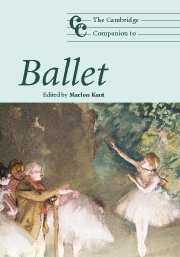Book contents
- Frontmatter
- Introduction
- Part I From the Renaissance to the baroque: royal power and worldly display
- 1 The early dance manuals and the structure of ballet: a basis for Italian, French and English ballet
- 2 Ballet de cour
- 3 English masques
- 4 The baroque body
- Part II The eighteenth century: revolutions in technique and spirit
- Part III Romantic ballet: ballet is a woman
- Part IV The twentieth century: tradition becomes modern
- Notes
- Bibliography and further reading
- Index of persons
- Index of ballets
- Subject index
- The Cambridge Companion to Music
1 - The early dance manuals and the structure of ballet: a basis for Italian, French and English ballet
from Part I - From the Renaissance to the baroque: royal power and worldly display
Published online by Cambridge University Press: 28 September 2011
- Frontmatter
- Introduction
- Part I From the Renaissance to the baroque: royal power and worldly display
- 1 The early dance manuals and the structure of ballet: a basis for Italian, French and English ballet
- 2 Ballet de cour
- 3 English masques
- 4 The baroque body
- Part II The eighteenth century: revolutions in technique and spirit
- Part III Romantic ballet: ballet is a woman
- Part IV The twentieth century: tradition becomes modern
- Notes
- Bibliography and further reading
- Index of persons
- Index of ballets
- Subject index
- The Cambridge Companion to Music
Summary
In the dance treatises of the fifteenth century choreographies were first recorded in Western Europe: dance became literary and philosophical as well as a physical skill and oral tradition. These treatises laid the foundation for the future structure of European dance. The main dance genres recorded in the treatises, ballo, bassadanza, and basse danse in the fifteenth century, pavane, galliard, branle, almain, balletto, bassa, brando and cascarda in the sixteenth century, were the dances of the upper levels of society: the courtiers and nobility, those who wielded power, as well as the wealthy merchants and trading families. Important state occasions, marriage celebrations, official visits by neighbouring rulers or ambassadors, annual religious festivities and theatrical events were all marked by formal balls or dancing at which members of the elite performed. Often these dance events took place in public spaces, on a stage erected in the main piazza in front of thousands of spectators. At other times the space in which the dancing was conducted was more private, being the main hall of a palace. But even on these occasions the dances performed were part of the official ceremonies and rituals, contributing to the presentation of the image of a ruler as a powerful and magnificent prince, whose authority could not be challenged. When a ruler and the leading members of his court danced in public before his subjects he was displaying his magnificence, and in doing so he was displaying his power. The Italians in particular were obsessed with protocol and ceremony, and one of the chief means of indicating rank was by spatial relationships among people.
- Type
- Chapter
- Information
- The Cambridge Companion to Ballet , pp. 7 - 18Publisher: Cambridge University PressPrint publication year: 2007
- 2
- Cited by

